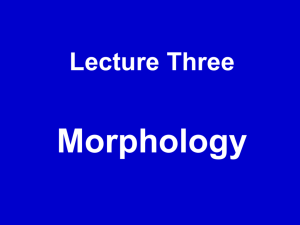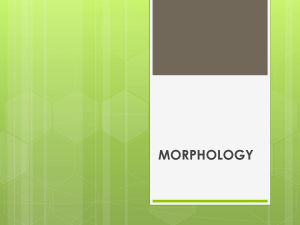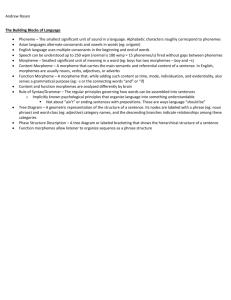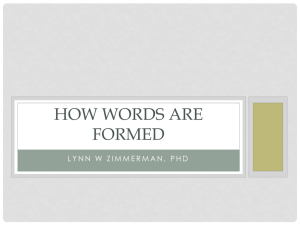Morphology - SchoolRack
advertisement
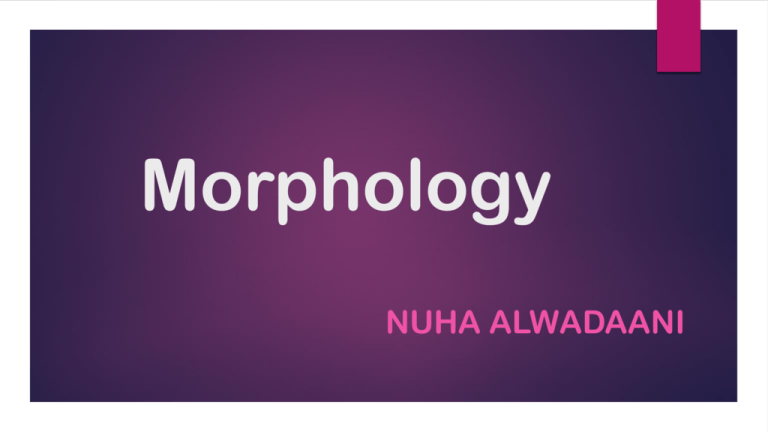
Morphology NUHA ALWADAANI Morphology Morphology is the identification, analysis, and description of the structure of a given language’s linguistic units. Morphology is the study of forms. It is the type of investigation that analyzes all those basic “elements” used in a language. The “elements” in the form of a linguistic message are technically known as “morphemes.” Morphemes We can recognize that English word forms such as talks, talker, talked and talking must consist of: • one element talk; • and a number of other elements such as –s, -er, -ed and –ing. The definition of a morpheme is “a minimal unit of meaning or grammatical function.” • Units of meaning: the units that holds the meaning. • Units of grammatical function: include forms used to indicate past tense or plural. For example, The police reopened the investigation. Reopened consists of three morphemes: One minimal unit of meaning open. Another minimal unit of meaning re-( meaning “again”). And a minimal unit of grammatical function -ed (indicating past tense). What about the word form “tourist”? Types of Morphemes Free Morphemes: morphemes that can stand by themselves as single words. For example, open and tour. • • Free morphemes can generally be identified as the set of separate English word forms such as basic nouns, adjectives, verbs, etc. Bound Morphemes: forms that cannot normally stand alone by themselves and are typically attached to another form, as re-, -ist, ed, -s. • All affixes (prefixes and suffixes) in English are bound morphemes. When free morphemes are attached to bound morphemes, the basic word forms are technically known as stems, for example: undressed un- dress carelessness -ed care -less -ness stem suffix suffix prefix stem suffix (bound) (free) (bound) (free) (bound) (bound) What is the difference between free stems and bound stems? We have agreed upon the fact that free stems are the free morphemes when attached with bound morphemes as in “dress” in undressed. However, in words such as “receive, reduce, and repeat”, we can identify the bound morphemes re- at the beginning, but the elements –ceive, -duce, and -peat are not separate word forms and hence CANNOT be free morphemes. These types are sometimes described as “bound stems” to keep them distinct from “free stems” such as dress and care. Categories of Free Morpheme Lexical Morphemes Functional Morphemes Lexical Morphemes (Open Morphemes): Words that carry the content of the message we convey. They are a set of ordinary nouns, adjectives and verbs. For example, girl, man, house, tiger, sad, long, yellow, sincere, open, look, follow, break. Functional Morphemes (Closed Morphemes): Functional words in the language, such as conjunctions, prepositions, articles, pronouns. For example, and, but, when, because, on, near, above, in, the, that, it, them. Categories of Bound Morphemes (Affixes) Derivational Morphemes Inflectional Morphemes Derivational Morphemes: We use these bound morphemes to make new words or words of a different grammatical category from the stem. For example –ness changes the adjective good to the noun goodness. Also, -ful and –less in careful and careless and –ish in foolish, -ly in quickly and –ment in payment. Moreover, prefixes such as re-, pre-,ex-, mis-, co-, un-, and many more. A derivational morpheme can change the grammatical category of a word. For example, the verb teach becomes the noun teacher if we add the derivational morpheme –er. Inflectional Morphemes: Suffixes used in indicate aspects of the grammatical function of a word. Used to show if a word is plural or singular, if it is past tense or not, and if it is a comparative or possessive form. English has only eight inflectional morphemes or (inflections): The possessive (-’s), the plural (-s), third person singular (-s), present participle (-ing), past tense (-ed), past participle (-en), comparative (-er), superlative (-est). o Nouns + -’s, -s. o Verb + -s, -ing, -ed, -en. o Adjective + -er. –est. An inflectional morpheme never changes the grammatical category of a word. For example, both old and older are adjectives. Whenever there is a derivational suffix and an inflectional one attached to the same word, they always appear in that order: First the derivational (-er) is attached to teach, then the inflectional (-s) is added to produce teachers. lexical (child, teach) free functional (and, the) morpheme derivational (-re, -ness) bound Inflectional (-’s, -ed) Problems in Morphological Description Page 71. Morphs Morphs are the actual forms used to realize morphemes. For example, the form cats consists of two morphs cat + -s (lexical morpheme + inflectional morpheme “plural”). Buses (lexical morpheme “bus”+ inflectional morpheme plural “-es”). Allomorphs A group of different morphs, all versions of ONE morpheme. For example, the actual morphs that result from the morpheme “plural” are different. Yet, they are all allomorphs of ONE morpheme: For example, the morpheme “plural”: Cats /s/ Buses /schwa+z/ Sheep Zero-morph/plural+ø/ /mεn/ men (irregular plural from the singular /mæn/). What are the allomorphs of the morpheme “past tense”?




